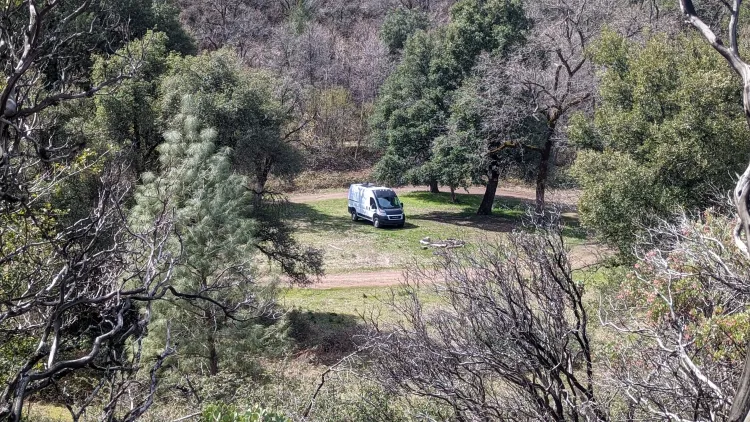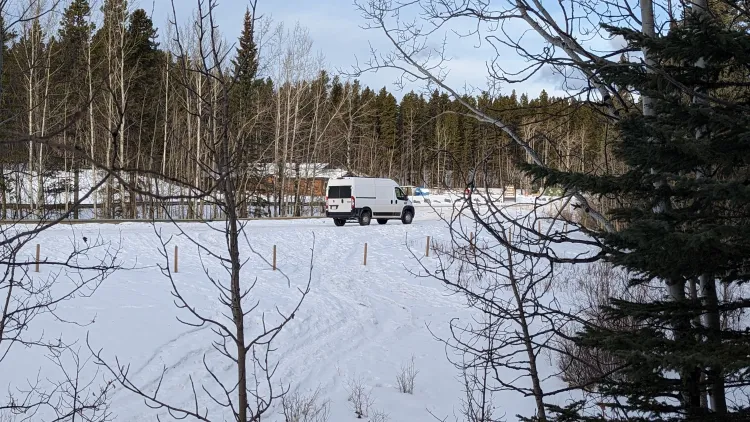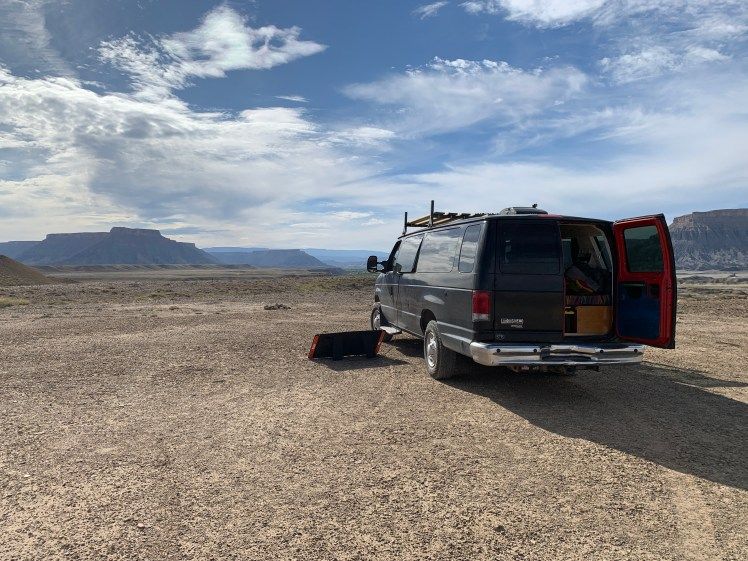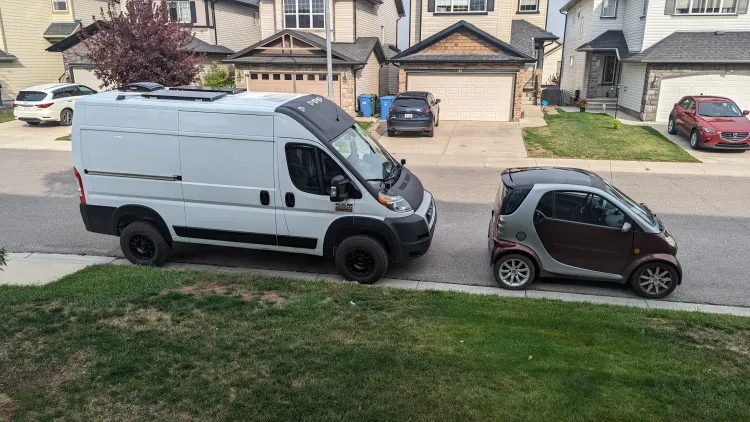Solar Power In The Winter - Surviving Van Life Winters Off The Grid

Even during the winter, if the sun is shining, you can harness its energy for your campervan's solar power system. In this post, we'll take a look at how solar power works during the winter, specifically in regards to van lifers looking to continue their adventures through the colder and snowier months.
Being a Canadian, I'm accustomed the the shorter, colder, snowier days. Since the inception of my van life plans, existing winter has always been a part of my planning. It's shaped my plans by where I want to travel, how I converted my van, and even the gear that I bring along with me on the road.
From the solar angle to the temperatures to snow cover, to the amount of solar wattage you have installed, this guide will answer all of your solar-powered questions!
Table Of Contents
An Introduction To Solar Power
One of the most complicated topics regarding van life is your electrical system. Many people get turned away by the complications and the science involved with this. If you take the time to learn the ins and the outs of van life electrical systems, you'll feel like you can tackle any problem on the road.
The solar system generally consists of a way to gather energy from the sun (solar panels), a way to control the energy and turn it into a stable source (charge controller), and then a way to store it (battery bank).
Solar power is at the heart of your system, harnessed through Photovoltaic (PV) solar panels. These panels act as electricity-capturing devices or photon receptors. In short, the panels work by the photon's exciting electrons which are then passed into your system. The efficiency of these panels is quantified in Watts (W), denoting their power output under standard conditions.
A solar charge controller is instrumental in regulating the energy flow from solar panels to batteries. It operates on the principles of Maximum Power Point Tracking (MPPT), a sophisticated technology optimizing energy transfer efficiency. Charge controllers work by levelling voltage and current which ensures the batteries receive an optimal charge without risk of overcharging.
Though there are many types of batteries, in the energy storage realm, lithium-ion batteries take the spotlight. Renowned for their high energy density and longevity, these batteries play a pivotal role in storing solar energy for use during periods of low sunlight.
After these components, you have plenty of options. From your batteries, you can then add several items like inverters to use household appliances, or a fuse block to use for 12V components.
Some solar systems have all of these components as separate pieces (Think Renogy/ Victron components). Other systems are as simple as plug and play between a battery (with everything you need) and solar panels (Think Jackery/ Bluetti, Anker portable power stations).
If you're looking for a deeper dive, check out Will Prowse's videos on solar systems:
How Much Solar Power Is Enough?

Solar panels are measured in Watts. Within reason, the more wattage you have, the more charge you will receive. How much solar power you choose to install on your van depends on a few important factors.
What you intend to power, how long you intend to stay off the grid, the weather of your environment, and what latitude you're at all play an important role in deciding how much solar wattage you should have.
Let's start by discussing the requirements for your particular situation:
- What will you be powering? Powering simple items like a phone, laptop, and fridge will have much fewer requirements than powering RV air conditioning units, electric kettles, and induction cooktops. A golden rule is to set up your system so that you can generate twice the amount of power you need through your solar panels, daily.
When you start to add up all of the luxuries that you could bring along, you may find yourself needing much more power than originally expected. - How long do you want to be off the grid? You'll want to factor in how long you want to remain away from shore power or how long you intend to sit without starting your vehicle. Take these considerations into your planning so you can properly size your solar system.
The longer you want to stay off-grid, the more robust of a system you will require. - What is the weather like in your environment? While those who boondock in the desert can likely depend on the sun daily, if you choose to stay in a rainforest in the PNW, you might have a harder time.
In the desert, you may not need as big of a battery bank since you can depend on the sun to keep up with your usage. In a rainy area, you may need multiple days' worth of battery backup, and a robust solar system to make the most of the infrequent breaks in the clouds. - What latitude will you be staying at? Similar to the weather, where you choose to stay is a big factor in how much solar you will need. Being closer to the equator will mean that the sun shines more directly on your solar panels for a larger portion of the year.
Alternatively, if you intend to stay in the northern parts of North America, you might struggle to replenish your batteries in the winter months.
Check out this site that shows what angles the sun is at at any given time of the year. - Daylight hours. When winter comes, the days get shorter. It's the season of "Go to work in the dark, come home in the dark". Because of this, you have fewer daylight hours to depend on to replenish your batteries. Check out this site that will tell you how many hours of sunlight there will be in the day.
Here's a video from Mowgli that can help you calculate your overall power needs so you can size your solar system properly:
How To Conserve Power In The Winter
With so many things vying to decrease your ability to generate solar power in the winter, you'll want to take some steps to compensate for these decreases in solar efficiency.
Here are some steps to maximize your solar system that work year-round:
- Use less power. Being able to cut back on your power consumption can leave more power for critical items like your heater or the ability to cook a warm meal. In the summer you may be able to get away with leaving your lights on while doing something around camp. During the winter, you'll want to conserve every ounce of power.
- Move with the weather. If possible, move around where the sun is shining. One of the largest benefits of van life is your ability to choose where you park. If you're not in a particular area to chase powder, or staying for work, perhaps moving somewhere with more sun will be more advantageous.
- Go south. Not only will going south provide you with more favourable weather, but the angle of the sun will be better for power generation the further south you go (within reason). Some people refer to this as "snowbirding".
I spent last winter in Utah, with a solar angle of roughly 30 degrees for my flat-mounted panels. I found this angle to be entirely adequate to keep me recharged without any worries. Additionally, moving south will bring along longer days as southern areas become less and less impacted by the shorter days of the north. - Angle your panels. Adding a means to keep your solar panels at an angle will help with capturing as much light as possible. While portable panels can be placed practically anywhere and at any angle, mounted panels can sometimes be permanently flat on the roof of your van. Adding the ability to angle your panels should help with winter solar power generation. In the U.S. angling your panels between 15 and 40 degrees, and facing south, is the recommended standard. Some calculations mention an ideal angle being the same as the latitude you're located at.
- Alternate charging methods. If you intend to brave the winter conditions, you may want to install an alternate means to keep your electrical system charged. While you may try and do everything possible to make the most of your solar power generation, it might not be enough.
Having a DC-DC charger, or shore power might be necessary to keep your van's electrical system running during the darkest parts of the winter. - Bolster your system. If you find your system isn't meeting your needs, it might not be big enough. Adding more solar panels, a stronger charge controller and more battery storage capacity might be enough to get you through the winter season. Do this within reason and your budget.
Do Solar Panels Work In The Winter In Canada?

Some unique environmental changes during Canadian winters can affect your solar system's ability to generate power. While Canada will be the focus, this information also works for any snowy, northern climate.
Let's get into it.
- Temperature. Temperature can have an impact on solar panels. Generally speaking, electronics run better when kept cool. The ability of photovoltaic(PV) panels to absorb solar rays is generally limited to -40F to +185F.
Keeping the panels cool will ensure it doesn't have to shut down due to overheating. Anything above 77F might cause the panels to lose more and more efficiency. - Daylight hours. Winter usually means shorter days. Shorter days mean that your solar panels don't have as much exposure to the sun. This means that you'll have less time in the day to recharge your battery.
- Sun angle. The angle the sun sits in the sky will have an impact on how much power you can generate, especially in the winter. In the northern hemispheres, the sun crosses the sky at a lower and lower angle until the winter solstice (21 December). While your solar panels will work, even with a small amount of light, they won't be nearly as efficient as if they were angled perfectly, with the sun perfectly in the sky.
This is why most solar farms permanently point their panels south at an angle depending on their altitude. You can still receive some solar input without a tilt, but it won't be nearly as effective. - Snow. Snow in the air and snow accumulation on your solar panels can all impact your total power generation. As expected, if it's snowing sufficiently that it's darker out, your panels will work accordingly. Similarly, if you have a foot of snow on your panels, it's unlikely that any light will penetrate through the snow.
- Battery chemistry. Your battery construction can be impacted by cold weather too. Classic batteries like AGM, or flooded can work poorly in cold temps. Same as lithium batteries. You'll want to come up with a way to keep your batteries warm so they can charge safely.
Take a look at this video with a crafty solution to keep their electrical system safe and warm:
You can't change many of these factors unless you move. If you're unable to relocate for the winter, then you'll need to take care of as many of these factors as you can.
How Do You Keep Snow Off Solar Panels?

Snow accumulation is something you'll need to prepare for during winter van life. Like any vehicle during snow storms, it will accumulate snow on top of it. Since solar panels are usually mounted on top of our vans, we need to ensure we keep the snow off if we want to generate any solar power during the winter.
Here are some tips:
- Clear Frequently. Much like shovelling snow, you'll want to clear the snow from your panels frequently. Instead of clearing 2 feet of snow, it would be easier to clear a few inches every few hours. This will also help with the compression of snow over time that may build into a stubborn layer of ice.
- Brush softly. Don't scrape off ice as it could damage the solar panel glass. Use a car wash with warm water to melt the ice.
- Park in the sun. When possible, moving your van to a sunny spot can help thaw out the snow on the panels. Not only will it melt it from above, but since the panels are black, they'll get warmer in the sun and help melt any accumulation from below too.
- Tilt Mounts. While installing your solar panels on a tilt mount allows you to make the most of the sun angles for charging, it also allows snow to slide off before it has a chance to accumulate.
- Use a blanket. Covering your solar panels during the worst weather could help with snow accumulation. Similar to winter windshield covers, using a blanket over your solar panels can ensure snow is easy to clear, and no stubborn sleet or ice builds up.
Of course, you won't be able to generate much power with a blanket stopping the light from hitting the panels, but you may not even generate power depending on how snowy the weather is.
Be cautious about using things like torches, heat guns, and hairdryers. These items will eliminate snow and ice quickly, but they may also wind up causing damage to your solar panels.
What Time Of Day Do Solar Panels Work Best?

The time of day your panel will work best is during solar noon. While the time fluctuates with latitude, or time of year, during the winter, you can expect that time to be between 10 am and 2 pm.
Due to the inherent challenges to solar power generation during the winter, you'll want to make sure you know how to make the most of any sun you get. Timing your ability to charge via solar is important if you want to get as much "free" power as possible.
Here's what you need to know:
- Check a solar almanac. Have a look at sites that have solar data. These websites will give you information on what hours of the day the sun will be the most intense.
- Clear your panels and get them ready. Similar to dealing with snow, you'll want to make sure your panels are as ready as possible to take any charge.
- Don't move. Parking your vehicle in a spot that has no obstructions will be better than driving around and going through the shade of trees, mountains, or buildings. This also allows you to practice more slow travel by enjoying a place more thoroughly before heading on with your adventures.
Additionally, if you don't have the means to tilt your solar panels, you can find a slanted parking spot that can angle your entire van in the direction of the sun. - Use more power during solar noon. If you need to recharge electronics, cook some food with an induction cooktop, or do anything else that will be power intensive, try and do so during peak sun time.
Doing this will decrease the draw on your battery reserves since you'll generate the most power mid-day. Leaving you with some power to last you through the night.
Taking these actions will help you overcome the challenges of winter solar power. The key is to be strategic and to make the most of the short sunlight hours.
Conclusion
In this post, we've covered the ins and outs of winter solar power.
Having a sound understanding of solar systems is key to thinking critically about your solar power system in the winter.
Knowing how much solar power you'll need, if panels work in northern climates, when is the best time for charging, and how to maintain your system during the cold and snowy months will give you the tools you need to stay off-grid this winter!
I'd love to hear from you!
Anything you want to add to solar power in the winter? Any questions? Comments? Let me know in the comments below!






Member discussion